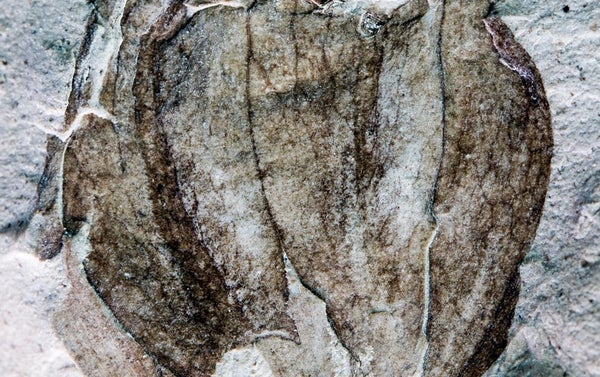Patagonia, dreamland for fossil hunters of enormous and ferocious dinosaurs, has yielded one of its most delicate and surprising paleontological fruits. Scientists have found the fossilized remains of tomatillos—popularly known as the central ingredient in salsa verde. The discovery represents the oldest evidence of plants within the genus Physalis, which are part of the Solanaceae family, or nightshades, a plant group that boasts among its members potatoes, tomatoes, chilies and tobacco. The fossils also add to evidence of the existence of a massive ancient supercontinent.
The paper was published last week in Science. The fossils were found at Laguna del Hunco in the Patagonian region of Argentina. “This is definitely the oldest record of this tremendously economically important plant family—52 million years,” says Rubén Cúneo, a researcher at the Egidio Feruglio Paleontological Museum in Argentina who was involved in the study.“We analyzed thoroughly every detail of these fossils in comparison to all potential living relatives, and there is no doubt that they represent the world’s first Physalis fossils and the first fossil fruits of the Solanaceae family,” says Peter Wilf from The Pennsylvania State University who also participated in the finding.
Wilf further explains that the genus Physalis is located near the ends of this family’s evolutionary tree, “which means that Solanaceae as a whole are much older than 52 million years, contrary to what was thought.” And, “given that the fossil’s characteristics are identical to the ones of the Physalis genus found today, it suggests that this modern and more derived morphological condition had already appeared more than 50 million years ago, in Patagonia, which speaks of the family’s tremendous initial diversification.”
On supporting science journalism
If you're enjoying this article, consider supporting our award-winning journalism by subscribing. By purchasing a subscription you are helping to ensure the future of impactful stories about the discoveries and ideas shaping our world today.
Physalis is made up of about 120 species, all native to the Americas, with most diversity found in Mexico. Until now Solanaceae’s fossil records have been limited to seeds and wood remains that shed little light on the plants’ evolution. For this reason, the fossilized tomatillos have a unique paleobotanical value. In addition, it is surprising that they belong to Physalis, whose fruits have inflated calyxes (delicate shells). “These fossils are rare because they are delicate and degrade easily once released from the mother plant,” Cúneo says.

Dried fruits of Physalis angustifolia, found in Florida, enable us to see the resemblance with the fossilized fruits found in Patagonia. Credit: Peter Wilf, Penn State
SCIENTIFIC AND ECONOMIC IMPORTANCE
“Understanding the early evolution of the Solanaceae family is important to understand how and under what conditions different traits useful for us humans have evolved, such as tubers in potatoes or fleshy fruits in tomatoes,” explains Tiina Särkinen, an expert on this plant family at the Royal Botanic Garden Edinburgh in Scotland who did not participate in the research. “These fossils will help understand that, and will allow Solanaceae experts to better locate our findings on that timescale. Fossil discoveries are extremely important because they show real evidence of past times. We can see what some of the species of this plant family looked like 52 million years ago. That's incredible,” she adds.
So far botanists had indirectly calculated the age of the Solanaceae family from molecular studies of modern specimens at about 22 million years. But these fossils tell a different story. “The age of these fossils was established based on radiometric dating using the argon–argon method in associated geological material and generating a difference of more than 30 million years in relation to the age calculated using molecular methods," Cúneo explains.
This new understanding of the evolutionary history and phylogeny of the plants may help scientists engineer better varieties of Physalis. Särkinen adds that any study focused on traits such as drought tolerance, resistance to pathogens, sugar content in fruits or any genetic pathway that controls a particular morphological characteristic is always based on the understanding of the evolutionary relationships of these plants.
GONDWANA HINTS
So far, these are the only Physalis fossils found among more than 6,000 paleontological remains collected at the Patagonia site. During a warm period many hundreds of millions of years ago the fossil discovery location was at the edge of the ancient supercontinent Gondwana, which would eventually split into the modern-day continents South America, Africa, Antarctica and Australia.
Researchers point out the new fossils show a rare connection between the late Patagonian plants of Gondwana and New World living plants. Most of the other fossil plants found on the site, however, have living relatives in Australasia, such as eucalyptus. This indicates there was a terrestrial connection through Gondwana during that time: from South America to Australia via Antarctica.
For Särkinen, one great question remains: Do these fossils really belong to an already extinct tomatillo species? “It’s exciting to think that this is a past relative of what we now eat in our sauces. It makes us wonder what else is there among the fossils. South America is especially important because so much remains to be discovered. Not only dinosaurs, but also plant fossils like these,” she says.
